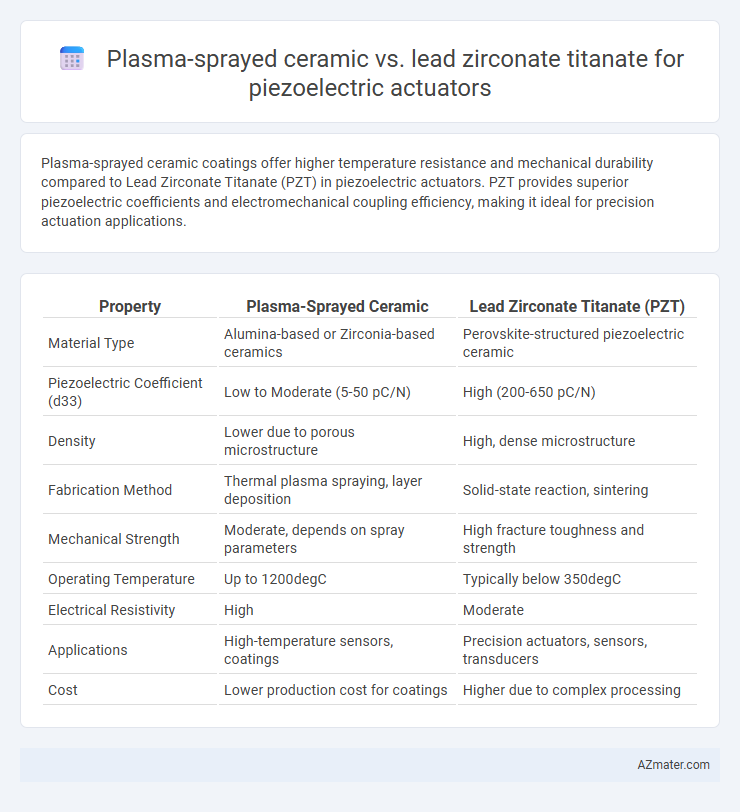Plasma-sprayed ceramic coatings offer higher temperature resistance and mechanical durability compared to Lead Zirconate Titanate (PZT) in piezoelectric actuators. PZT provides superior piezoelectric coefficients and electromechanical coupling efficiency, making it ideal for precision actuation applications.
Table of Comparison
| Property | Plasma-Sprayed Ceramic | Lead Zirconate Titanate (PZT) |
|---|---|---|
| Material Type | Alumina-based or Zirconia-based ceramics | Perovskite-structured piezoelectric ceramic |
| Piezoelectric Coefficient (d33) | Low to Moderate (5-50 pC/N) | High (200-650 pC/N) |
| Density | Lower due to porous microstructure | High, dense microstructure |
| Fabrication Method | Thermal plasma spraying, layer deposition | Solid-state reaction, sintering |
| Mechanical Strength | Moderate, depends on spray parameters | High fracture toughness and strength |
| Operating Temperature | Up to 1200degC | Typically below 350degC |
| Electrical Resistivity | High | Moderate |
| Applications | High-temperature sensors, coatings | Precision actuators, sensors, transducers |
| Cost | Lower production cost for coatings | Higher due to complex processing |
Introduction to Piezoelectric Actuators
Piezoelectric actuators utilize materials that generate mechanical displacement under an electric field, with Lead zirconate titanate (PZT) being the most widely used due to its high piezoelectric coefficients and stability. Plasma-sprayed ceramics offer a novel fabrication method, enabling the deposition of thick piezoelectric layers with tailored microstructure and improved adhesion on complex substrates. Comparing plasma-sprayed ceramic actuators to conventional PZT reveals differences in material density, porosity, and electromechanical performance crucial for optimizing actuator design in precision applications.
Overview of Plasma-Sprayed Ceramic Materials
Plasma-sprayed ceramic materials used for piezoelectric actuators offer high-temperature stability and enhanced wear resistance, making them suitable for harsh environmental applications. These ceramics exhibit controlled microstructure and porosity, which directly affect their piezoelectric properties and mechanical strength. Compared to lead zirconate titanate (PZT), plasma-sprayed ceramics provide better thermal shock resistance but may demonstrate lower piezoelectric coefficients depending on the material composition and spray parameters.
Lead Zirconate Titanate (PZT): Properties and Applications
Lead Zirconate Titanate (PZT) exhibits superior piezoelectric properties such as high dielectric constant, large electromechanical coupling coefficient, and excellent ferroelectric behavior, making it ideal for precision actuator applications. Unlike plasma-sprayed ceramics, PZT offers enhanced stability, repeatability, and sensitivity, enabling its widespread use in sensors, actuators, and ultrasonic transducers. Its ability to convert electrical signals into mechanical displacements at micro-scale resolution drives advanced applications in robotics, medical devices, and adaptive optics.
Material Composition and Microstructure Comparison
Plasma-sprayed ceramic piezoelectric actuators typically comprise aluminum oxide or zirconia-based ceramics with a porous microstructure, resulting in lower density and reduced piezoelectric performance compared to dense materials. Lead zirconate titanate (PZT) features a perovskite crystal structure with a dense, homogeneous microstructure that enhances its piezoelectric coefficients and electromechanical coupling efficiency. The compositional differences--PZT's complex Pb(Zr,Ti)O3 lattice versus simpler plasma-sprayed ceramic oxides--directly influence their dielectric constants, mechanical strength, and actuator sensitivity.
Fabrication Techniques and Scalability
Plasma-sprayed ceramic techniques enable rapid deposition of piezoelectric layers with controlled thickness and microstructure, suitable for larger-scale production due to their scalability and cost-effectiveness. Lead zirconate titanate (PZT), often fabricated via sol-gel or tape-casting followed by sintering, offers superior piezoelectric properties but involves more complex, time-consuming processes that limit mass production scalability. The plasma spray method supports flexible substrate application and industrial-scale manufacturing, whereas PZT fabrication demands stringent controls on stoichiometry and crystallinity for optimal actuator performance.
Piezoelectric Performance Metrics: Sensitivity and Efficiency
Plasma-sprayed ceramic coatings exhibit high mechanical robustness and thermal stability but generally provide lower sensitivity and piezoelectric efficiency compared to lead zirconate titanate (PZT) in piezoelectric actuators. Lead zirconate titanate demonstrates superior piezoelectric coefficients (d33 values often exceeding 300 pC/N) and electromechanical coupling factors, resulting in enhanced sensitivity and energy conversion efficiency. PZT remains the preferred material for high-performance actuators due to its optimized microstructure and intrinsic ferroelectric properties, which are critical for maximizing actuator responsiveness and durability.
Durability and Mechanical Strength Analysis
Plasma-sprayed ceramic coatings offer superior mechanical strength and wear resistance compared to Lead zirconate titanate (PZT), enhancing the durability of piezoelectric actuators in harsh environments. PZT, while exhibiting high piezoelectric sensitivity, tends to be more brittle and susceptible to fatigue failure under cyclic loading, limiting its lifespan in mechanically demanding applications. The enhanced toughness and thermal stability provided by plasma-sprayed ceramics extend actuator operational life by mitigating crack propagation and mechanical degradation.
Environmental Stability and Temperature Resistance
Plasma-sprayed ceramic coatings exhibit superior environmental stability, resisting humidity, corrosion, and mechanical wear better than Lead zirconate titanate (PZT) in harsh conditions. Temperature resistance is notably higher in plasma-sprayed ceramics, maintaining piezoelectric performance at elevated temperatures up to 1000degC, whereas PZT typically degrades above 300degC. These attributes make plasma-sprayed ceramics more suitable for high-temperature and chemically aggressive environments in piezoelectric actuator applications.
Cost-Effectiveness and Manufacturing Challenges
Plasma-sprayed ceramic piezoelectric actuators generally offer improved cost-effectiveness due to lower material and processing expenses compared to Lead Zirconate Titanate (PZT), which involves complex synthesis and sintering steps. However, plasma-sprayed ceramics face manufacturing challenges like achieving uniform microstructure and consistent piezoelectric properties, whereas PZT benefits from well-established fabrication techniques but incurs higher costs from raw materials and multi-stage processing. Balancing material cost, actuator performance, and production scalability remains critical in selecting between plasma-sprayed ceramics and PZT for piezoelectric actuator applications.
Future Trends and Emerging Applications
Plasma-sprayed ceramic coatings offer enhanced thermal stability and mechanical robustness compared to Lead zirconate titanate (PZT), making them promising for high-temperature and harsh-environment piezoelectric actuator applications. Emerging trends indicate increasing integration of plasma-sprayed ceramics in aerospace and automotive sectors for vibration control and energy harvesting due to their superior durability and customization capabilities. Future research focuses on optimizing plasma spray parameters to improve piezoelectric response and developing multifunctional devices combining sensing and actuation in smart systems.

Infographic: Plasma-sprayed ceramic vs Lead zirconate titanate for Piezoelectric actuator
 azmater.com
azmater.com